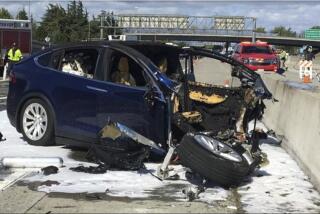THE CUTTING EDGE / REPORTER’S NOTEBOOK : Predicting the Cyber Future: Wallet PCs or Consumer Unease?
- Share via
LAS VEGAS — “Mom, can you squirt me a twenty?”
So asks the young hero of a lavish cops-and-robbers video that Microsoft Chairman Bill Gates used in his keynote speech at the annual Comdex computer trade show to demonstrate his vision of our electronic future, circa 2005. By then, he predicts, we’ll all be paying for caffe lattes and concert tickets with wallet PCs that stock digital hoards of cash, serve as instant ID cards and even store hundreds of pictures of our children.
Police officers and other mobile workers will have sleek dashboard screens that can display video of the boss back at the office and call up maps and directions to any place the driver wants to go. Video conferences will be possible from any public phone booth. Paramedics can collaborate with hospital-bound doctors and nurses from moving ambulances. How will all this come to pass, given the relatively low penetration of computing devices into U.S. households and the nation’s continued level of technological skills, as evidenced by the blinking 12:00s on VCRs across the land?
Well, the good news is that most of the technology is already here. The bad news is that much of it is too expensive for most people--and it’s difficult even for professionals to tell which of the many divergent technologies on display at Comdex will ultimately be important. Vision, as Gates himself once said, is the easy part.
*
IBM, Apple Computer and Motorola know a thing or two about the distance between concept and reality. The three companies agreed three years ago to work together on a new computer chip, but only last month did they agree on a common design for personal computers using that chip.
At Comdex, the three companies showcased applications of more than 30 software developers in their massive white tent in the Las Vegas Convention Center parking lot, but they said little about the conflicts over operating-system software that still hobble the alliance.
Ironies abound when it comes to the PowerPC. Some industry observers are prematurely counting Apple out of the PC race. But numbers released at Comdex by Dataquest Inc., a San Jose research firm, show that Apple emerged as the leading U.S. computer vendor for the third quarter. Apple says it is on target to ship 1 million Power Macintosh units during the machine’s first year on the market.
And Microsoft, in many ways a dreaded Apple foe, actually has at least part of a foot planted in Apple’s camp. Mark Lewin, whose Microsoft business card identifies him as the Technical Evangelist of the systems developer relations group, has been spending most of his energies coordinating the development of Windows NT applications for the PowerPC.
Lewin insisted Microsoft is “fully committed to both platforms.” Indeed, Microsoft has long been a leading developer of Macintosh applications software, but some grumble that the company has been suspiciously slow rewriting its programs for the Power Mac.
*
Kai (rhymes with sky) Krause is considered something of a wizard in the computer graphics field, known for his mastery of Adobe Photoshop and for developing so-called plug-in software that can enhance Photoshop.
His company, HSC Software, is gradually severing its ties with Adobe Photoshop, releasing stand-alone imaging software programs that, thanks to amazingly complex mathematical computations, can spin, twist, expand, reconfigure and color images in the wink of an eye.
A long-haired math genius with a walrus mustache who grew up in Essen, Germany, Krause first made a name for himself by disseminating a 10-page tip sheet on how to do “algorithmic painting” over America Online years ago. Since then, the tips have been downloaded more than 200,000 times. Two years ago, HSC came out with Kai’s Power Tools to help graphic designers quickly create splashy images and 3-D renderings on Macintoshes, Windows machines or Silicon Graphics workstations. The company’s latest product is KPT Bryce. It can create mind-boggling natural and supernatural landscapes.
HSC, which has expanded to 80 employees from eight, recently outgrew its Santa Monica offices and moved to Carpinteria, near Santa Barbara. And Krause and his family will soon move to Montecito, having sold the Malibu house that narrowly escaped last year’s fire.
Krause, executive vice president, figures that by the time his two children (another is on the way, or “in beta,” as he put it) are old enough to comprehend what he’s doing, new graphics offerings will make his work look like the digital equivalent of a Model T.
“Our kids will laugh at us,” he said. Maybe so, but for now Krause appears to have all the right stuff.
More Computer News * The TimesLink on-line service includes a large selection of articles and information about computers and technology in its Business section. Sign on and “jump” to keyword “Computer News.”







